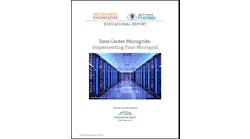What solar installer hasn’t seen a homeowner’s face drop upon learning that rooftop solar panels don’t spare the home from an outage when the electric grid goes down?
“I’ve invested in solar. I’m really excited because I’ve declared myself as independent from the power grid. I feel good because I’m a green citizen. Until I realize that as soon as the utility grid goes away, I stop producing,” said Farid Dibachi, CEO and founding partner of JLM Energy. “For a lot of new owners of a solar PV system, that’s a rude awakening.”
But a home microgrid can change all that. And JLM Energy is at the forefront of the market with its recent roll-out of the Energizr.
To be clear, neighborhood microgrids already exist that serve homes. What’s different here is that the home becomes a microgrid onto itself, complete with generation, storage and intelligence that allows it to island from the main grid during a storm.
JLM Energy’s home microgrid offers three compelling benefits, Dibachi said.
1. It generates and stores energy onsite for use when it’s needed. Eg. When a family gets home from work it can use battery power collected during the day from the solar panels.
2. The PV system continues to collect energy even if the grid is down.
3. The house has power even when a blackout leaves everyone else in the neighborhood in the dark.
What’s the market for the system? Only the rich folk? Dibachi says no, at least not in California, where the state self-generation incentive program (SGIP) can cut by 60 percent the system’s cost, which is otherwise $15,000 (for self-install) or $20,000 (installed). This doesn’t include the cost of the solar panels.
The anatomy of a home microgrid
The basic Energizr is 4.4 kW with 8.8 kWh of storage (or multiples of that), designed to receive the maximum California incentive.
An energy management system connects to the bank of batteries, the grid, an optional back-up generator, solar PV (or a wind turbine) and the home’s electric load — the refrigerator, lights, TV, microwaves, coffee makers, etc.
The solar panels supply electricity to the home, and deliver any leftover power to the batteries. Or the grid can charge the batteries. If the system realizes the grid is not available, and the batteries are nearly drained, it turns on the optional backup generator to charge the batteries. The homeowner can choose to run the house off the Energizr or the grid.
Update: Check out the latest news on home microgrids:
- Disasters and outages wake homeowners to the benefits of home microgrids
- A hydrogen microgrid for a home? A California utility achieves first step
- US builder plans 200,000 home microgrids using zinc batteries
- PG&E’s ‘personal microgrid’ device aims for home resiliency in fire-prone areas
- Demand for Home Microgrids Surges in Response to California Fires
- Why the Luxury Home Market is Primed for Microgrids
“It treats the grid, the solar system and the generator as sources of energy. It uses what needs to be used by the load and anything leftover is stored in the batteries,” he said.
When a grid outage occurs, the system automatically switches to the battery storage in a way that is seamless.
“Not even a blink, not even a noticeable flicker in your light bulbs,” he said. “A lot of our customers told us an outage occurred and they didn’t even know there was an outage.”
When the system is in island mode, a sensor continually checks to see if the grid power has come back on, so that it can reconnect the house when the time comes.
The back-up generator and grid connection are optional; the system can work completely off the grid with renewable energy.
The system includes the smarts that allow for energy price management, particularly valuable if the local utility makes time-of-use pricing available. But the company discourages new owners from taking on the task until they know the system well.
The Energizr is designed as a retrofit for homes that already have solar panels or can be installed in conjunction with a new PV system.
The company will install the solar panels itself in some cases, but mostly works with about 200 dealers around the U.S. The product received UL certification in early 2014. The company then installed over two dozen systems in the homes of what it calls ‘early adopters,’ before recently releasing it to the broad market.
The technology opens the door for aggregating homes for the buying and selling of power and other services into grid markets. The company is in talks with dealers in PJM’s territory that are interested in these market possibilities.
Emotional appeal
Dibachi sees the home microgrid as more than just a practical appliance; it also taps into a desire for local energy.
“This gets you to a place where you can declare your independence from the grid,” he said. “You no longer have to be at the mercy or the control of a government sanctioned monopoly called a utility company.”
Why is this important?
When you buy grid power, you are paying that bill without being able to argue price, he said.
“Our economy is built on multiple suppliers competing for our business as consumers; yet we pay for one of the most important parts of our lives every day without the benefit of anybody competing,” he said.
So we knew it was coming and here it is: the home as its own power plant. The market is likely to be largely confined to California for now. Still, with both solar and battery prices dropping, and energy management systems growing both friendlier and more astute, expect to hear about additional companies offering home microgrids in 2015.
What do you think? Will the home microgrid be as commonplace someday as the microwave and air conditioner? Tell us your thoughts on LinkedIn at Microgrid Knowledge.






